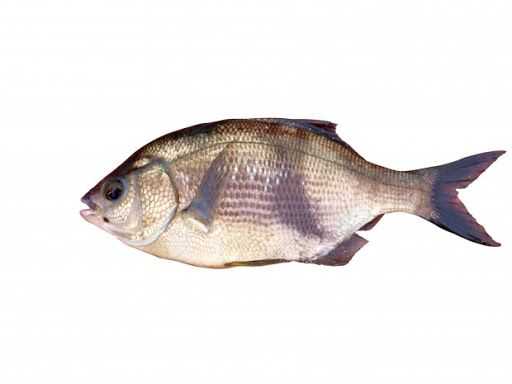Pile Perch

Species Details
Rhacochilus Vacca
Embiotocidae
Perciformes
Reefs, inshore, offshore
3 - 4 lbs.
15" - 17"
Pile Perch (Rhacochilos vacca) Fish Description
The Pile Perch fish, commonly known as Pile Surfperch, splittail perch, dusky perch, forktail perch, white perch, piler perch, silver perch, and porgy.
They are often distinguished by the black spot located on their cheek, deeply forked tail, and the long, first soft rays on their dorsal fins that are around twice the height of their last spines.
Pile Perch are of a bronze-like to brown color, with a silver side and underside. They are often found with yellow pelvic fins. They have a dusky, vertical stripe across from the high point of the soft dorsal. The position of the bar and their deeply forked tail can be used to distinguish them from the sargo, or white seabream.
Diet & Size
Pile Perch fish diets consist primarily of mussels, pile worms, barnacles, snails, and even small shore crabs. They can feed at any depth of the water column but mainly feed at the bottom. Pile Perch can grow up to 17.4 in. in length, but the average length they are caught at is around 10-14 in. They can weigh up to 4.4 lbs.
Interesting Facts about Pile Perch
- The scientific name of the Pile Perch, Rhacochilos vacca, originates from the Greek root words racos (ragged) and cheilos (lips) and the Latin word vacca (like a cow).
- The Pile Perch’s tail can be found usually pinkish with an ocassional orange spot on its anal fin.
- Unlike the Walleye surfperch, no black coloration can be found on the Pile Perch’s pelvic fins.
- Pile Perches mate during fall to early winter seasons. The male advances towards the female from below, and both swim with their vents close for about 2-3 second, until they separate and repeat the process. Around 3 to 16 young perch are born the next seasons of spring and summer.
- Pile Perch, like other Surfperch fish, are ranked within the top ten fishes that can be caught by anglers in central and northern California.
Fishing Techniques
The Pile Perch is a favored catch for shore anglers for game fishing in bays throughout the state, but make no mistake they can be quite frustrating to catch. Large Pile Perch can be observed swimming languidly in clear view close to mussel-covered pilings, almost outright rejecting to take in the baits offered up by anglers. However, they seem to be a little easier to fish for during spawning season, when they’re in dense schools.
The customary setup for catching Pile Perch is to use a high/low leader with a number 6 or 4 hooks, a light line, and also a light sinker.
Pile Perch are often nestled up next to the pilings, rocky areas where mussels are sure to be abundant. Check for shorelines by the pier that is low tide and grab some local bait. If you’re in southern California fishing, the best baits to use would be fresh mussels, rock crabs, or bloodworms. If in the Bay Area, you can try grass shrimp, rock crabs, pile worms, or fresh mussels. Fresh mussels as bait would be optimal because this is considered to be a Pile Perch fish favorite.
But oftentimes mussels as bait are difficult to keep on the hook, so to solve this try this method.
- Try and remove the mussels from their shells with a dull knife, but as much as possible retain the mussel’s beard with the mussel.
- Now, holding the mussel’s beard, insert a short shank hook (number 2 or 4) into and through its tongue, and the same through its meat of the body.
- Twist the hook around, push up to the point of the hook through the base of its beard.
- Then finally, trim the beard and the excess meat with a pair of scissors. Now, there’s less likelihood of the bait falling off of its hook.
Habitat and Distribution
Pile Perch are often found ranging from Isla Guadalupe, central Baja California, Mexico to southern British Columbia. Some sources even say they’ve been observed in Port Wrangell, Alaska.
They commonly inhabit shallow water, rocky areas, around piers and docking points, in bays and ocean fronts. Frequently they are bottom-dwellers, classified as “benthic grazing carnivores.” While others would merely call them commuter fish, moving in between different habitats in search of their prey. Adult Pile Perch are seen along rocky shores, around kelp, pilings, and other underwater structures, and in depths of water reaching up to 150 ft.







